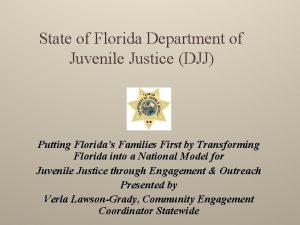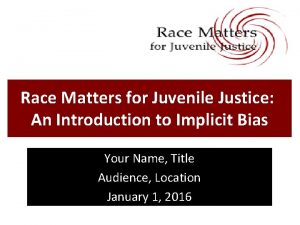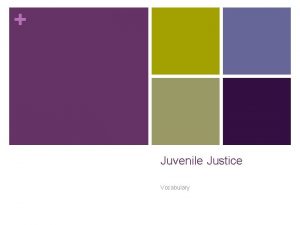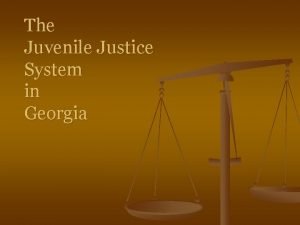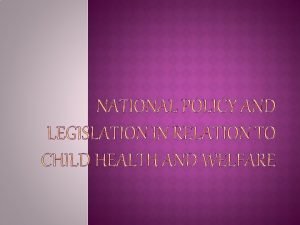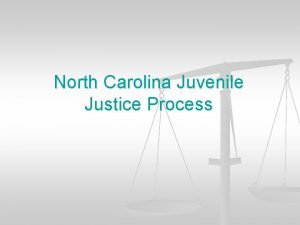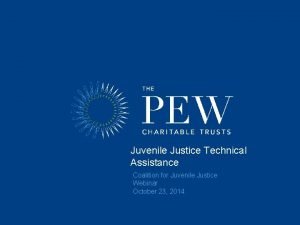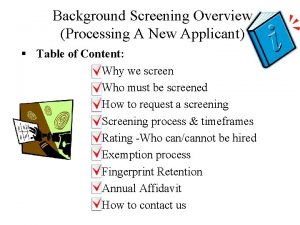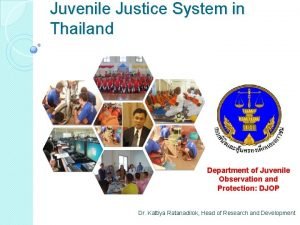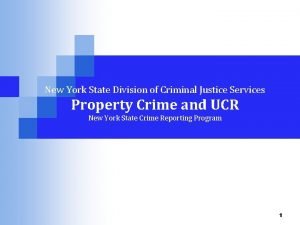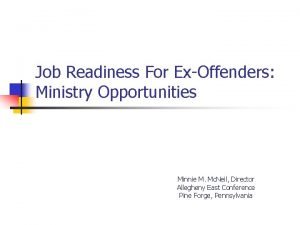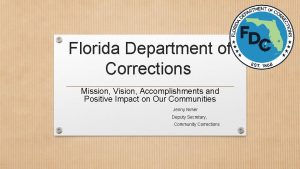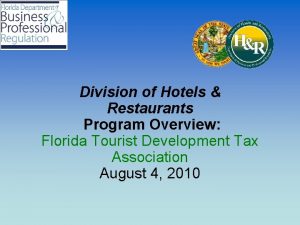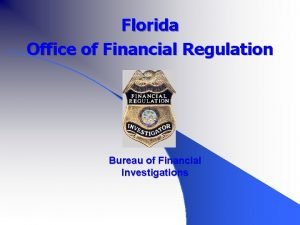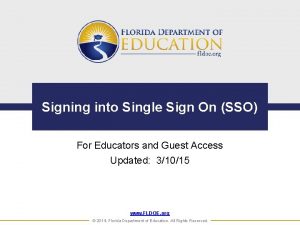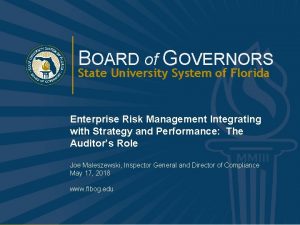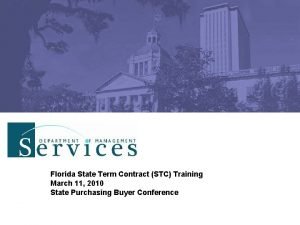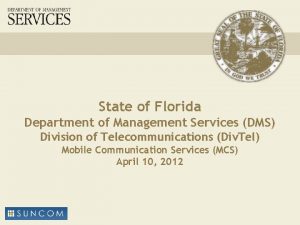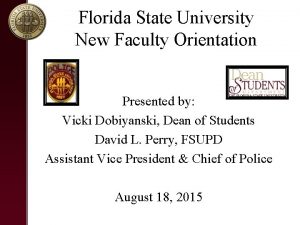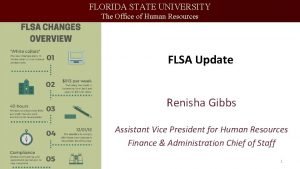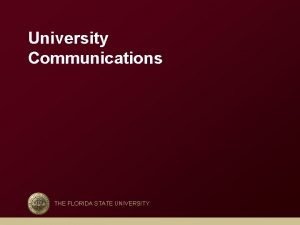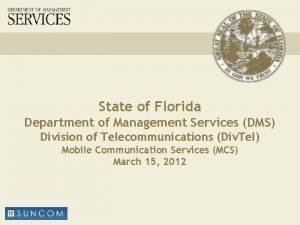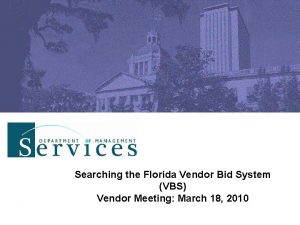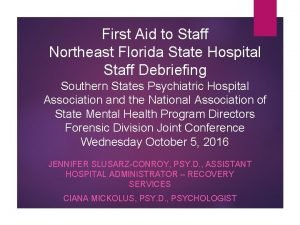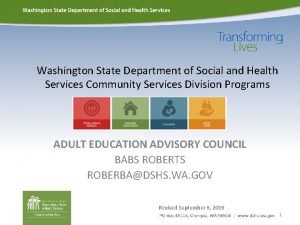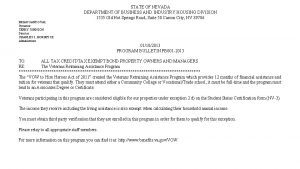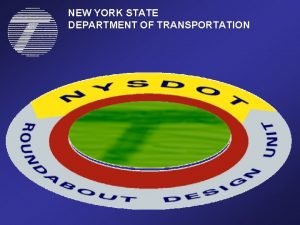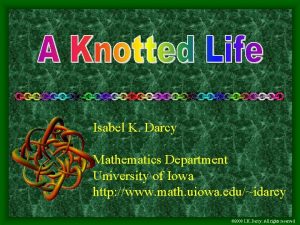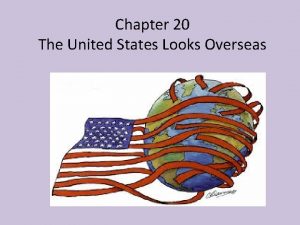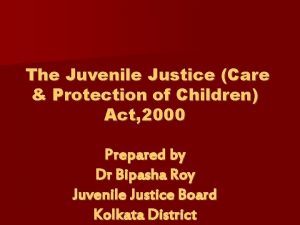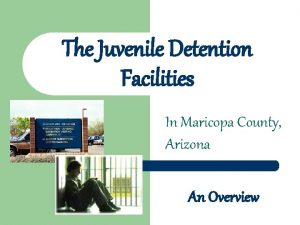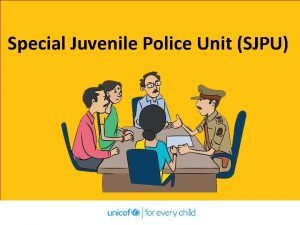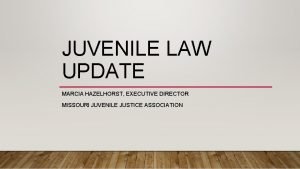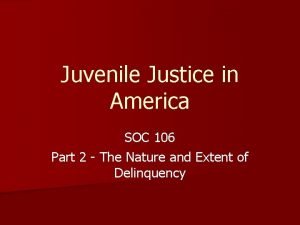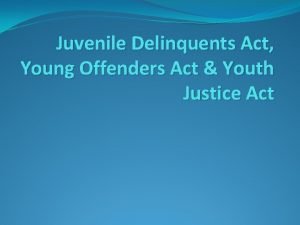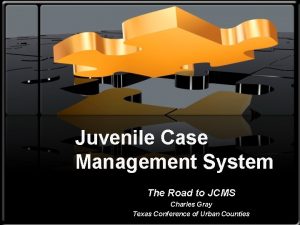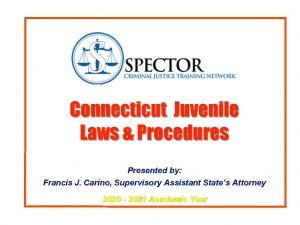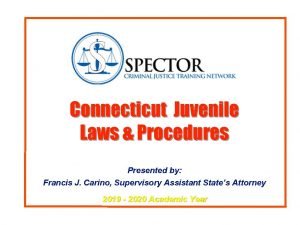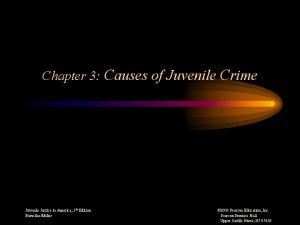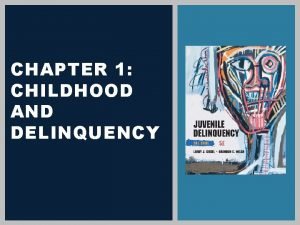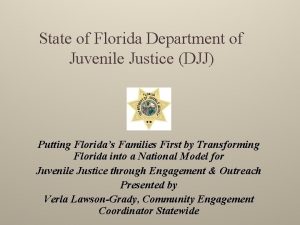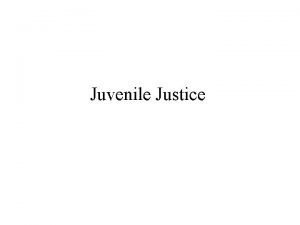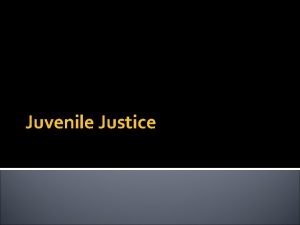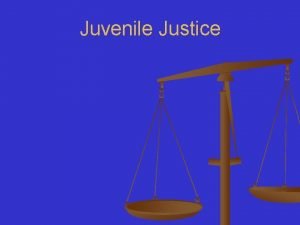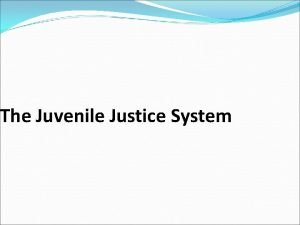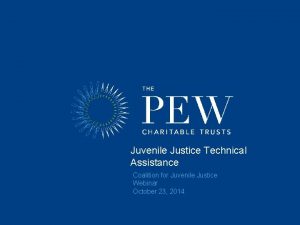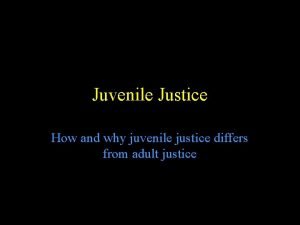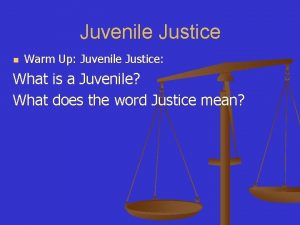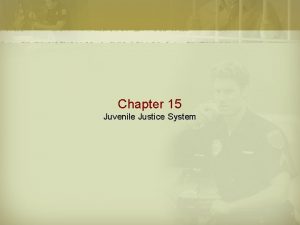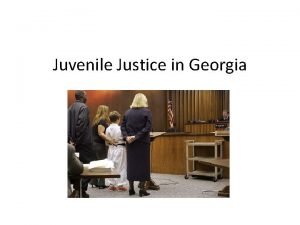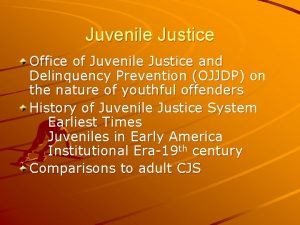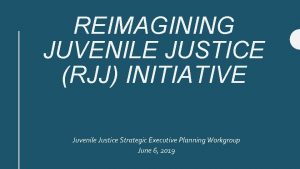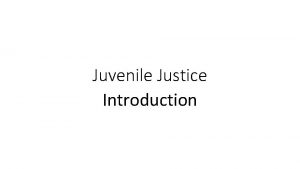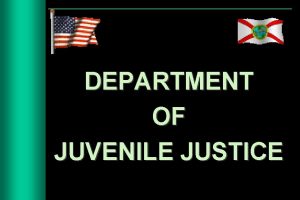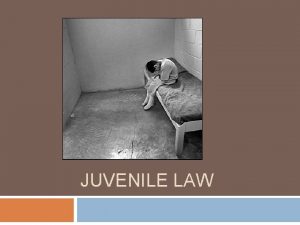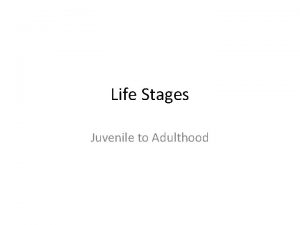State of Florida Department of Juvenile Justice DJJ





































































- Slides: 69

State of Florida Department of Juvenile Justice (DJJ) Putting Florida’s Families First by Transforming Florida into a National Model for Juvenile Justice through Engagement & Outreach Presented by Verla Lawson-Grady, Community Engagement Coordinator Statewide

COMMUNITY ENGAGEMENT & OUTREACH Ø DJJ Manages more than 120, 000 juvenile delinquency cases each year. On any given day, DJJ has more than 5, 000 children in secure custody. Ø DJJ launched a statewide reform effort in 2011.

Putting Florida's families first Objective: Manage resources by meeting the needs of youth, families and communities.

Community Engagement/Outreach Ø Prevention met the challenge in 2011. Ø In conjunction with Management’s Reform efforts, I developed Community Conversations. Ø Youth Law Enforcement Focus Groups, currently known as GAAP (Gaining Appreciation by Adjusting Perspectives) discussions Statewide.

COMMUNITY OUTREACH AND ENGAGEMENT ØCommunity Conversations began in May 2013. ØPurpose: Meet with communities on a more grassroots level, collaborate and build stronger partnerships with stakeholders and providers.

COMMUNITY OUTREACH AND ENGAGEMENT Ø Community Conversations were developed to meet with Florida’s communities, discover what their immediate needs are and develop ways in which DJJ might collaborate in a more proactive way to offer assistance. Ø Community Engagement & Outreach is a standard way to identify certain specific needs in communities and to provide necessary services.

Out reach & engagement ØWe have hosted Community Conversations statewide in over 60 Counties and 18 Circuits. ØTo date approximately 4, 000 youth and families have attended and participated.

Outreach & engagement Priorities ØAddress overrepresentation of minority youth. ØPromote Civil Citation ØStrengthen relationships between youth and law enforcement ØStrengthen community partnerships ØFund programs that are needed and have measureable results

OUR goals Ø Prevent and divert youth from entering the juvenile justice system. Ø Provide appropriate less restrictive, community based sanctions and service.

goals (continued) Ø Reserve serious sanctions for youth who post the greatest risk to public safety. Ø Focus on rehabilitation.

How do we accomplish our goals? Ø Implement new philosophies, (i. e. , Roadmap to System Excellence) • The Roadmap to Systems Excellence details specific strategies to aid Florida's families, explain how resources will be shifted.

Roadmap to system excellence Prevent and divert more youth from entering the Juvenile Justice System through Engagement and Outreach

Outreach & engagement Ø Prevention is the First component on the continuum of services. Ø Saves money and decreases the chance of system involvement Ø Focus on youth at risk for arrest and community needs. –Risk factors –Protective factors –Behavior

Develop alternatives to incarceration? HOW? Utilize effective prevention services and assessment tool's. Identify and implement alternatives to secured detention. Shift residential resources to community-based interventions.

What Types of prevention programs are currently implemented in Florida? Prevention Programs Children In Need of Services / Families In Need of Services (CINS/FINS) Ø Runaway and troubled youth ages 10 to 17 and their families. Ø Non-residential counseling, case plans, case management services, adjudication services, CINS Petition Process, staff secure services, physically secure services and case termination. Outward Bound School Ø Wilderness expeditions and follow up. Ø PACE CENTER FOR GIRLS Ø Where the Future Shines and the Past Fades. Ø Small classes where your teacher cares about you, knows your name and understands how girls learn. Ø You will be able to speak up without being judged.

Practical Academic Cultural Education Center for Girls, Inc. (PACE) Ø Non-residential services for girls ages 12 to 17. Ø Comprehensive and holistic model that integrates social services, education and career readiness.

Prevention Services Ø Provide prevention and diversion programs statewide. Ø Programs funded through either contract or competitive grants Ø Programs include contracts for Children and Families in Need of Services and Female Diversion Ø Programs include Federal Grants for: Ø Staying in school/After School Ø Job training Ø Parenting Skills Ø Living violence free Ø Tutoring/Mentoring Ø Programs that provide services to neighborhoods with the highest number of juvenile referrals Ø Programs which target high risk youths

ELEMENTS OF REFORM ØBy shifting our focus – and our investments – to the front end of the system, we will save not only money, but also lives.

Outreach and engagement ØThrough Community Engagement, Outreach and Community Partnerships we save lives.

Engagement & outreach Target high risk juveniles Provide early interventions Promote Use of Civil Citation

PREVENTION engagement & outreach ØWhile delinquency cases in Florida have been declining for the past several years, those numbers are still far too high.

Outreach & Engagement with the Faith Community Ø One major initiative is to improve Community Outreach & Engagement is to involve the Faith Community. Ø They provide programs and services to youth and their families. Ø Work with youth and their families during times of family crisis.

DJJ”s VISION &Prevention Services ØDJJ plans to shift residential resources to community-based interventions. ØRealign existing resources to increase the availability of transitional services.

DJJ’S VISION/PREVENTION ØSuch as services for vocational programming ØEmployment ØEducation ØFamily support ØTransitional housing and transportation.

Community engagement & outreach Ø Work with juvenile justice stakeholders to increase community-based prevention & diversion services available to at-risk-youth. Ø Promote Civil Citation. Ø Strive to keep youth out of the deeper end of the juvenile justice system while not compromising public safety.

our vision Ø Use data to measure the effectiveness and outcomes of services. Ø Ensure appropriate utilization of residential beds and redesign existing resources. Ø Shift residential resources to prevention and community-based interventions.

Prevention priorities ØReduce juvenile arrest and recidivism. ØReduce the number of youth penetrating deeper into the juvenile justice system.

Prevention priorities ØReduce disproportionate minority contact (DMC). ØFund programs that work, and have measurable results. ØStrengthen partnerships with community stakeholders.

THANK YOU! Verla. Lawson-Grady@djj. state. fl. us (850) 717 -2423

BREAK

Faith Network Craig Swain Faith Network Coordinator

What is the Faith Network? The Faith Network is a combination of individuals, ministries, organizations, and congregations from all faiths who are working collectively in each judicial circuit to help prevent and reduce juvenile delinquency across the State of Florida, by providing direct services and advocating for youth.

What is the Faith Network’s Mission? The mission of the Faith and Community Network is to provide a full range of programs and services to prevent and reduce juvenile delinquency through partnerships with faith and community-based organizations.

Commitment F. S. 985. 17 1(a) : The department shall engage faith and community-based organizations to provide a full range of voluntary programs and services to prevent and reduce juvenile delinquency, including, but not limited to, chaplaincy services, crisis intervention counseling, mentoring, and tutoring.

Church & State relationship Free Exercise Clause: Prevent government from interfering with or attempting to hinder or regulate any citizen’s religious beliefs. Establishment Clause: Prevent government from setting up church and passing laws that aid one religion

Services • • Worship Services Life Skills Religious Book Study Pastoral Care/Counseling • Faith-based life skills • • Mentoring Transitional Services Tutoring Professional Development • Gender Specific

Engaging the Faith Community • • • Circuit Advisory Boards Faith Network Conference Calls Community Conversations Circuit Faith Network Meetings Circuit Faith Forums National Faith Symposiums

The Faith Network • Faith Network Basic Training • Faith volunteers in every circuit • Faith volunteers providing service at every stage of our continuum • More than 600 people participated in the 2014 National Faith Symposium

Faith Network Activities Circuit 2 Faith Network Basic Training

Faith Network Activities Circuit 12 Faith forum Circuit 6 Faith Forum

Educating & Advocacy • • Civil Citation DMC/RED Human Trafficking Direct File

For More information • Visit www. djj. state. fl. us • Partners, Providers & Staff • Faith Community Network

Craig Swain (850) 717 -2442 Craig. Swain@djj. state. fl. us Faith Network Coordinator Florida Department of Juvenile Justice

RED RACIAL AND ETHNIC DISPARITIES IN THE JUVENILE JUSTICE SYSTEM

Terminology • Racial and Ethnic Disparities (RED) – According to the Burns Institute website “Racial and ethnic disparity (RED) refers to unequal treatment of youth of color in the juvenile justice system. RED results in disparate outcomes for similarly situated youth”

What Causes Overrepresentation? • Differential Treatment – Harsher, More Likely Punishment – Policing Patterns – Stricter Probation Conditions • Institutional Bias – Biased assessment tools; disparities in sentencing (5 years for 10 grams of crack OR 100 grams of powder cocaine) • Personal Bias – Implicit Bias vs Explicit Racism

Decision points Each point of contact includes decisions and processes that may introduce or worsen disparity: • Arrest – More officers in minority neighborhoods = more arrests from minority neighborhoods • Detention – Risk Assessment Instruments that are unintentionally biased – Detention holds for FTAs/VOPs/VCOs

• Diversion – Historically offered more for white youth (not true of Civil Citation) • Probation – Stricter conditions may make violations more likely

So Where Do We Start? • According to the Center for Children’s Law and Policy RED Practice Manual, work to reduce RED must be informed by the following principles: – All youth should be treated fairly and as individuals – Adolescents do not have the maturity and judgement of adults – Incarceration should be reserved for youth who represent a significant danger to the community – Reform efforts should include families and communities – Reform efforts should be culturally responsive and linguistically competent

Sentencing Incarceration should be reserved for youth who represent a significant danger to the community • Florida Civil Citation Initiative • Juvenile Detention Alternatives Initiative

Reform efforts • This is where you come in! • You know your communities and the relevant stakeholders better than we do • Circuit Advisory Board engagement and education • Strategic Planning

Current Initiatives • Training and Technical Assistance to Circuit Advisory Boards • RED/DMC Law Enforcement Officers – Ft. Lauderdale and Orange County – Training, Data Analysis, Youth Focus Groups

• Law Enforcement Curriculum and Training – Addresses many of the key principles discussed above – Has been implemented in 9 different agencies with trainings scheduled or pending with 15 additional agencies and 2 regional public safety institutes

Overview of Circuit Advisory Boards

Objectives • Maximize communication between DJJ and the community, juvenile justice advocates, and legislature • Assist DJJ in developing community understanding and awareness on DJJ focus areas • Assist DJJ in ensuring that juvenile justice programs are developed and implemented. 2

Circuit Advisory Boards F. S. 985. 664: authorizes that: a juvenile justice circuit advisory board is to be established in each of the 20 judicial circuits. The purpose of each juvenile justice circuit advisory board is to provide advice and direction to the department in the development and implementation of juvenile justice programs and to work collaboratively with the department in seeking program improvements and policy changes to address the emerging and changing needs of Florida’s youth who are at risk of delinquency. 56

Why Are Circuit Advisory Boards Important? They provide important resources that help fulfill the department’s mission: To increase public safety by reducing juvenile delinquency through effective prevention, intervention and treatment services that strengthen families and turn around the lives of troubled youth. 57

Why Are Circuit Advisory Boards Important? • Resources such as: Time Energy Expertise Credibility Status or influence

What are the duties of the Circuit Advisory Boards? • Developing and submitting to DJJ a comprehensive plan for the circuit every three years; • Participating in the facilitation of interagency cooperation and information sharing; 59

What are the duties of the Circuit Advisory Boards? • Providing recommendations for public or private grants to be administered by a community partner that support the comprehensive plan; • Providing recommendations to DJJ in the evaluation of prevention and early intervention grant programs; and • Providing an annual report to DJJ by August 1 of each year describing the circuit advisory board’s activities.

Circuit Advisory Boards Representation The Circuit Advisory Board must have a minimum of 16 members that reflect the circuit’s geography and population distribution and diversity. The following members are required to be on the advisory board, do not have any term limitations, and do not require approval of the Secretary of DJJ: 61

Circuit Advisory Boards Representation State attorney or designee; Public defender or designee; Chief judge or designee; Sheriff or designee from each county in the circuit; Police chief or designee from each county in the circuit; County commissioner or designee from each county in the circuit; and • Superintendent or designee of each school district in the circuit. • • • 62

Boards Representation (continued) The following members are required to be on the advisory board, but must be approved by the Secretary of DJJ before serving and are limited to three consecutive two-year terms: • Representatives from the: – Department of Children and Families; – Workforce organization of each county in the circuit; – Business community; – Faith community; • A youth representative who has experience with the juvenile justice system and is not older than 21 years of age; • A health services representative who specializes in mental health care, victim service programs, or victims of crimes; • A parent or family member of a youth who has been involved with the juvenile justice system; and • Up to five representatives chosen from community leaders and youth-serving coalitions. 63

Committees There shall be the following standing committees of the Board, which shall be perpetual in duration, and which shall have the following functions: Grant Committee - shall make recommendations on prevention grants to the DJJ; Legislative Committee - shall develop the Board’s Legislative Platform consistent with Board and DJJ’s priorities, and develop strategies for advocating with the Legislature on priorities; Disproportionate Minority Contact Committee - shall develop and support strategies that reduce the number of minority youth who have contact with the juvenile justice system. Faith Community Network Committee – shall engage representatives of the faith community in addressing juvenile issues; and Planning Committee – shall develop and implement planning for events that will be carried out by the Board, i. e. Juvenile Justice Week. Nominations and Membership Committee – To nominate new officers and to recruit new members.

Sunshine Law Requires that any communication between two or more group members of a matter that could foreseeably come before the group may take place only in a meeting in the “Sunshine” that is properly noticed and where minutes are taken. 65

Statutory Requirements: When applicable, the Sunshine Law requires: • Meetings must be open to the public; • Reasonable notice provided including agenda where possible; and • Minutes must be taken.

Sample Advisory Board Activities/Initiatives • • • Recognition luncheons Juvenile Justice Week events Circuit Teen Summits Circuit Wide Conferences Community Forums Teen Centers 67

Circuit Advisory Boards

Patrice Richardson Office: (850) 717 -2443 http: //www. djj. state. fl. us Circuit Advisory Board Liaison Email: Patrice. Richardson@djj. state. fl. us
 State of florida department of juvenile justice
State of florida department of juvenile justice Race matters for juvenile justice
Race matters for juvenile justice Criminal law and juvenile justice unit 2
Criminal law and juvenile justice unit 2 R.a. 9344
R.a. 9344 Juvenile justice vocabulary
Juvenile justice vocabulary Juvenile justice alternative education program
Juvenile justice alternative education program Georgia juvenile justice system
Georgia juvenile justice system Juvenile justice act 2000
Juvenile justice act 2000 North carolina juvenile justice
North carolina juvenile justice Juvenile justice system in georgia
Juvenile justice system in georgia Coalition for juvenile justice
Coalition for juvenile justice Minnesota juvenile justice system
Minnesota juvenile justice system Djj
Djj Djj-khh-jgggg-hfff
Djj-khh-jgggg-hfff Djj background check
Djj background check Djj scrap connect
Djj scrap connect Penurunan kepala 5/5
Penurunan kepala 5/5 Djj normal
Djj normal Department of juvenile observation and protection
Department of juvenile observation and protection Miami-dade county juvenile services department
Miami-dade county juvenile services department Department of criminal justice services ny
Department of criminal justice services ny Us department of justice
Us department of justice Florida department of corrections mission statement
Florida department of corrections mission statement Florida department of hotels and restaurants
Florida department of hotels and restaurants Florida dept of agriculture and consumer services
Florida dept of agriculture and consumer services Pyramid scheme vs ponzi
Pyramid scheme vs ponzi Florida department of education single sign on
Florida department of education single sign on Fran carino juvenile law
Fran carino juvenile law Public health internships ct
Public health internships ct Florida state university computer science
Florida state university computer science Board of governors state university system of florida
Board of governors state university system of florida Florida state term contracts
Florida state term contracts Ssef categories
Ssef categories State of florida management services
State of florida management services Fsu orientation
Fsu orientation Board of governors state university system of florida
Board of governors state university system of florida Fsu human resources
Fsu human resources Florida state university communications
Florida state university communications Dms state of florida
Dms state of florida Florida vbs
Florida vbs Nefsh
Nefsh Washington state department of social and health services
Washington state department of social and health services State of nevada department of business and industry
State of nevada department of business and industry State of nevada department of business and industry
State of nevada department of business and industry State of alabama department of finance
State of alabama department of finance Texas state university psychology
Texas state university psychology New york state department of transportation
New york state department of transportation University of iowa math
University of iowa math The state department us for
The state department us for Oklahoma state standards
Oklahoma state standards Penn state meteorology certificate
Penn state meteorology certificate Jackson state university finance department
Jackson state university finance department State of nevada department of business and industry
State of nevada department of business and industry Michigan state university physics
Michigan state university physics Juvenile act
Juvenile act Maricopa county juvenile detention center
Maricopa county juvenile detention center Sjpu
Sjpu Dermatomyocytis
Dermatomyocytis Missouri juvenile officer performance standards
Missouri juvenile officer performance standards Juvenile delinquents act
Juvenile delinquents act Soc 106
Soc 106 Newspaper article on juvenile delinquency
Newspaper article on juvenile delinquency Juvenile delinquents act canada
Juvenile delinquents act canada Juvenile case management system
Juvenile case management system Francarino
Francarino Fran carino juvenile law
Fran carino juvenile law According to choice theorists offenders
According to choice theorists offenders Juvenile
Juvenile What is the nature and extent of juvenile delinquency
What is the nature and extent of juvenile delinquency Objectives of studying juvenile delinquency
Objectives of studying juvenile delinquency
